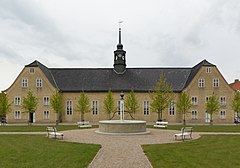Sídla založená moravskými bratry
| Sídla založená moravskými bratry | |
|---|---|
| Světové dědictví UNESCO | |
 | |
| Smluvní stát | |
| Typ | kulturní dědictví |
| Kritérium | iii, iv |
| Odkaz | 1468 (anglicky) |
| Zařazení do seznamu | |
| Zařazení | 2015 (39. zasedání) |
| Změny | 2024 |
Sídla založená moravskými bratry je nadnárodní památka světového dědictví UNESCO, která zahrnuje 4 sídla v Evropě a USA. Dánský Christiansfeld figuruje na seznamu od roku 2015, zbývající tři sídla byla zapsána v roce 2024 (Herrnhut v Německu, Bethlehem v USA a Gracehill ve Spojeném království). Města byla založena moravskými bratry. Každá osada má svůj architektonický ráz vycházející z ideálů moravské církve, ale přizpůsobený místním podmínkám. Společně představují nadnárodní působnost a konzistenci mezinárodní moravské komunity jako globální sítě. Ve všech městech je i nadále aktivní náboženský sbor, kde tradice pokračují a tvoří živé moravské dědictví. Osady se vyznačují charakteristickou zástavbou, jako jsou obecné domy, kostely a sborovny (obecní byty pro svobodné muže, ženy a vdovy), a také symetrickým urbanistickým uspořádáním.
Fotogalerie
- Christiansfeld
- Gracehill
- Herrnhut
- Bethlehem
Média použitá na této stránce
Autor: Mactographer, Licence: Attribution
A photo I captured of Stonehenge in April of 2009.
Autor: Villy Fink Isaksen, Licence: CC BY-SA 4.0
v databázi dánské památkové agentury Slots- og Kulturstyrelsen.
Autor: Ardfern, Licence: CC BY-SA 3.0
Moravian Church, Church Road, Gracehill, Ballymena, County Antrim, Northern Ireland, September 2009
Autor: SchiDD, Licence: CC BY-SA 4.0
Seminargebäude in Herrnhut, Civitatenweg 1
Autor: w_lemay, Licence: CC BY-SA 2.0
Built in 1741 and expanded with a matching addition in 1743, this log building served as a community house for the Moravian settlers of Bethlehem, and was the first major structure constructed by the group. The building was home to various functions of the community early on, including being the location of communal cooking and dining, with this later moving to the Bell House, and a worship space in a large second-story room known as the Saal, which was the first place of worship for the Moravians at Bethlehem, which was replaced by the Old Chapel in 1751. The building was also utilized as a medical center, apothecary, and school early on, and was the place where botanist and mycologist Lewis David de Schweinitz, whom was a great-grandson of Count Nikolaus Ludwig von Zinzendorf und Pottendorf, was born in 1780, with Lewis David de Schweinitz later going on to contribute greatly to the study of native fungi and plants in North America in Pennsylvania and North Carolina. The building became home to the clergy of the Moravian Church by 1796, and was often known as the Clergy House from that point onwards. The building became apartments by the mid-19th Century, and was a home for elderly women run by the Moravian Church from 1923 until 1964. The building is a log structure clad in weatherboard siding, with a side gable slate roof, shed dormers, six-over-six and two-over-two double-hung windows, stoops at the entry doors on the front facade, a shed-roof rear wing and porch, and a stone base clad in stucco. The building has been utilized as the Moravian Museum of Bethlehem since 1966. The building was listed individually on the National Register of Historic Places in 1975, and is a contributing structure in the Central Bethlehem Historic District, listed on the National Register of Historic Places in 1972, and expanded to include additional buildings in 1988, and a contributing structure in the Historic Moravian Bethlehem District, listed on the National Register of Historic Places and as a National Historic Landmark in 2012.













